U-BOATS TO BRING ENGLAND TO HEEL
Berlin, Germany · November 29, 1939
On this date in 1939, nearly three months after the German Wehrmacht overran neighboring Poland, launching World War II in Europe, German dictator Adolf Hitler issued Fuehrer Directive Number 9, the first of two directives on measures his country would have to take to render the British economy and infrastructure incapable of sustaining the war against Nazi Germany. Titled “Instructions for Warfare against the Economy of the Enemy,” the focus of Directive Number 9 was on attacking British merchant and escort vessels, destroying port installations, and blockading the sea lanes leading to them using U‑boats, mines, and S‑boats (fast torpedo boats known to the Allies as E‑boats). The British and later their North American allies responded with naval and aerial convoy systems to protect the water lifeline to the British Isles in this Battle of the Atlantic. The second directive, Number 23, “Directions for Operations against the English War Economy,” issued on February 6, 1941, acknowledged that the measures taken during the preceding fourteen months had not so far had any “discernible” effect on British morale or their capacity to “resist.” With the prospect of moving substantial Luftwaffe units from the French Channel coast to the Eastern Front for Operation Barbarossa (June 1941), Germany’s planned liquidation of the Soviet Union in eight to ten weeks, Hitler thought it was possible keep the British off balance by progressively stepping up submarine operations against merchant shipping in coordination with bombing the key centers of military aircraft production to both inflict the greatest possible damage and simulate the appearance of a German invasion of their isles, codenamed Operation Sea Lion. (The one small-scale Sea Lion test exercise off Boulogne, southwest of Calais in German-occupied northern France, conducted in good weather and good visibility, with no navigation hazards or enemy defenses to contend with, portended a dicey, even unsuccessful amphibious assault on southern England.) Thus, the period from 1940 to 1942 represented the best chance Germany had to win the Battle of the Atlantic: a total of 973 Allied ships were lost. And up through 1943 the Kriegsmarine, with as many as 100 U‑boats at sea at any time (January 1943), came terrifyingly close to winning the Battle of the Atlantic.
[amazon_carousel widget_type=”ASINList” width=”600″ height=”200″ title=”Recommended Reading” market_place=”US” shuffle_products=”False” show_border=”False” asin=”0773512829,1416591109,1591149584,1844153665,030681160X,0752461877,0465091563,0679640320,0679640339,0465029612″ /]
German U-Boats and the Earliest Days of the Battle of the Atlantic
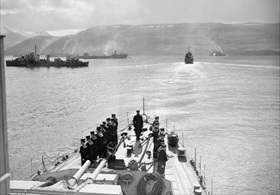 | 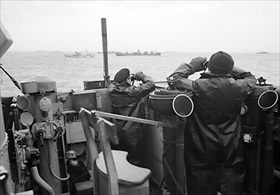 |
Left: Escorts and merchant ships at the Hvalfjord (Hvalfjörður) naval base, Iceland, late June 1942. During the World War II nearly one-third of the world’s merchant shipping was British. Out of 36,000 merchant seamen who lost their lives between 1939 and 1945, over 30,000 were from the British Merchant Navy. More than 2,400 British ships were sunk out of the total of 2,900 Allied ships lost, or a loss of 14.6 million gross tons. A little over 9,500 U.S. merchant marines died at sea, in POW camps, or of their wounds out of the roughly 243,000 who served. (The U.S. government never kept accurate records for its merchant marine.) Most of the ships sunk during the Battle of the Atlantic were not in convoys, but sailing alone, or had become separated from convoys.
![]()
Right: Officers on the bridge of an escorting British destroyer keep a sharp look out for enemy submarines, October 1941.
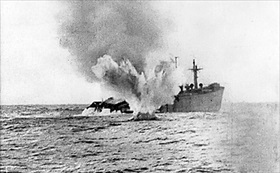 | 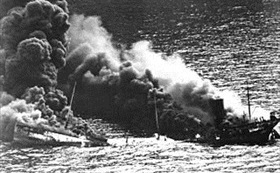 |
Left: An unnamed U-boat shells a merchant ship that had remained afloat after being torpedoed (no date). The focus on U‑boat successes, the “aces” and their scores, the number of convoys attacked, and the ships sunk obscures the fact that during the Battle of the Atlantic only 10 percent of transatlantic convoys were ever attacked, and of those attacked only 10 percent on average of the ships were lost. Overall, more than 99 percent of all ships sailing to and from Great Britain during World War II did so safely.
![]()
Right: The 8,046-ton U.S. tanker Dixie Arrow was torpedoed by U‑71 on March 26, 1942. The ship is shown crumbling amidships under the heat of fire. Between June 1, 1941, and May 31, 1943, the U‑71 carried out ten war patrols. Operating out of the huge U‑boat pens at St. Nazaire, France, U-71 on her fifth foray sank 38,894 tons of shipping between March and April 1942. She was scuttled on May 2, 1945, in Wilhelmshaven, Germany, several days before the country’s surrender.
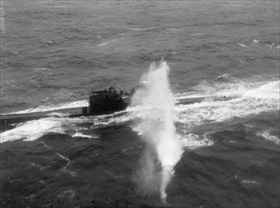 | 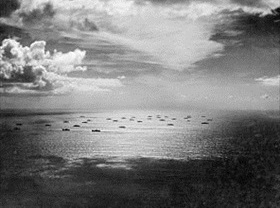 |
Left: A Royal Navy, Fleet Air Arm Grumman TBF Avenger fires its machine gun on the conning tower of U‑288 during a convoy run to the Soviet Union, April 3, 1944. The U‑boat was eventually sunk by rockets and depth charges. Forty-nine men died; there were no survivors. The Kriegsmarine lost a total of 783 submarines and 30,000 sailors during the war. Despite their best efforts, German submarines failed to stop the flow of strategic supplies to Britain. Between existing Allied merchant ships, U.S.-built Liberty ships (totaling 38.5 million tons), and British-built Empire ships, the Allies launched millions more ship tonnage than the 14 million tons of shipping lost to the U‑boat menace.
![]()
Right: At the height of the Atlantic campaign, U-boats failed to hinder or even detect the U.S. invasion fleet headed to North Africa in November 1942 (Operation Torch), and they failed to prevent the build-up of troops and supplies needed for the D-Day landings in June 1944. As early as May 1943, when a fifth of his U‑boats was sunk in “Black May,” Grand Admiral Karl Doenitz conceded that Germany had lost the Battle of the Atlantic.
U-Boats of the Kriegsmarine and the Earliest Days of the Battle of the Atlantic
![]()

 History buffs, there is good news! The Daily Chronicles of World War II is now available as an ebook for $4.99 on Amazon.com. Containing a year’s worth of dated entries from this website, the ebook brings the story of this tumultuous era to life in a compelling, authoritative, and succinct manner. Featuring inventive navigation aids, the ebook enables readers to instantly move forward or backward by month and date to different dated entries. Simple and elegant! Click
History buffs, there is good news! The Daily Chronicles of World War II is now available as an ebook for $4.99 on Amazon.com. Containing a year’s worth of dated entries from this website, the ebook brings the story of this tumultuous era to life in a compelling, authoritative, and succinct manner. Featuring inventive navigation aids, the ebook enables readers to instantly move forward or backward by month and date to different dated entries. Simple and elegant! Click 











